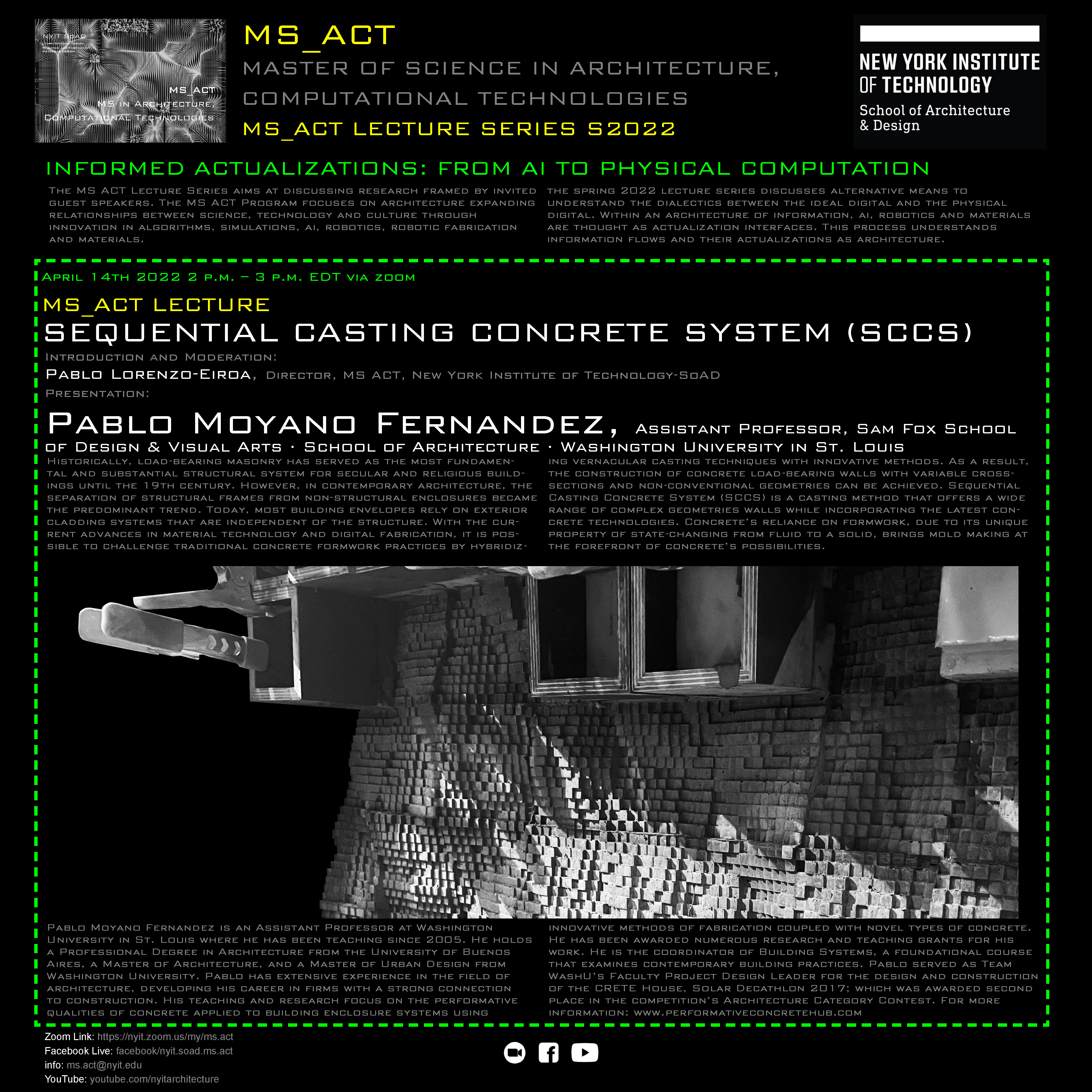Architecture Computational Technologies
Explore design research at the frontiers of architecture through experimentation in computational design, robotic systems applied to fabrication and interactivity, and materiality. For more information please contact ms.act@nyit.edu
S2022 MS ACT Lecture: Sequential Casting Concrete System (SCCS) Pablo Moyano Fernandez
MS_ACT
Master Of Science In Architecture, Computational Technologies
MS_ACT LECTURE SERIES S2022
Informed actualizations: From AI to physical computation
The MS ACT Lecture Series aims at discussing research framed by invited guest speakers. The MS ACT Program focuses on architecture expanding relationships between science, technology and culture through innovation in algorithms, simulations, ai, robotics, robotic fabrication and materials. The spring 2022 lecture series discusses alternative means to understand the dialectics between the ideal digital and the physical digital. Within an architecture of information, ai, robotics and materials are thought as actualization interfaces. This process understands information flows and their actualizations as architecture.
Introduction and Moderation:
Pablo Lorenzo-Eiroa, Director, MS ACT, New York Institute of Technology-SoAD
Presentation:
Pablo Moyano Fernandez,
Assistant Professor in Architecture, Sam Fox School of Design & Visual Arts ∙ School of Architecture ∙ Washington University in St. Louis
Sequential Casting Concrete System (SCCS)
Historically, load-bearing masonry has served as the most fundamental and substantial structural system for secular and religious buildings until the 19th century. However, in contemporary architecture, the separation of structural frames from non-structural enclosures became the predominant trend. Today, most building envelopes rely on exterior cladding systems that are independent of the structure.
With the current advances in material technology and digital fabrication, it is possible to challenge traditional concrete formwork practices by hybridizing vernacular casting techniques with innovative methods. As a result, the construction of concrete load-bearing walls with variable cross-sections and non-conventional geometries can be achieved. Sequential Casting Concrete System (SCCS) is a casting method that offers a wide range of complex geometries walls while incorporating the latest concrete technologies.Concrete’s reliance on formwork, due to its unique property of state-changing from fluid to a solid, brings mold making at the forefront of concrete’s possibilities.
Pablo Moyano Fernandez is an Assistant Professor at Washington University in St. Louis where he has been teaching since 2005. He holds a Professional Degree in Architecture from the University of Buenos Aires, a Master of Architecture, and a Master of Urban Design from Washington University. Pablo has extensive experience in the field of architecture, developing his career in firms with a strong connection to construction. His teaching and research focus on the performative qualities of concrete applied to building enclosure systems using innovative methods of fabrication coupled with novel types of concrete. He has been awarded numerous research and teaching grants for his work. He is the coordinator of Building Systems, a foundational course that examines contemporary building practices. Pablo served as Team WashU’s Faculty Project Design Leader for the design and construction of the
CRETE House, Solar Decathlon 2017; which was awarded second place in the competition’s Architecture Category Contest. For more information: www.performativeconcretehub.com
Instagram Handle: @pablo_stl
Zoom Link: https://nyit.zoom.us/my/ms.act
Info: ms.act@nyit.eduYouTube: https://www.youtube.com/channel/UC3kjiPr82e1pGkPKaZ6hjnQ
https://blogs.nyit.edu/msact
More Posts
All PostsMay 31, 2022
MS_ACT INNOVATION KEYNOTE LECTURE Kaicong Wu
May 26, 2022
MS ACT Lecture Shai Yeshayahu
May 16, 2022
